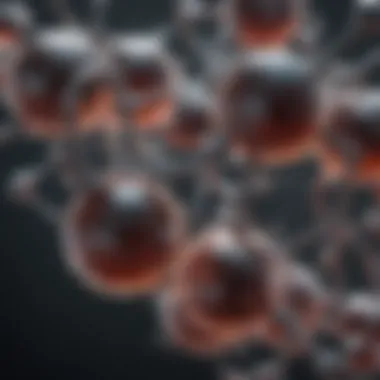Hydrolyzation: Mechanisms, Applications, and Implications


Intro
Hydrolyzation is a fundamental biochemical process with vast implications across numerous scientific fields. At its core, it involves the breaking down of complex molecules into simpler ones through the addition of water. Understanding the mechanisms, applications, and broader implications of this process allows for a deeper appreciation of its role in both natural and industrial contexts.
As we embark on this exploration of hydrolyzation, we will dissect the chemical reactions that govern its operation, delve into practical examples, and examine the significance of hydrolyzation in environmental science. The goal here is to inform students, researchers, educators, and professionals about the nuances of hydrolyzation and its relevant contributions to science and technology.
The following sections will elaborate on the structural components of hydrolyzation, providing a cohesive narrative that bridges foundational knowledge with contemporary applications.
Understanding Hydrolyzation
Hydrolyzation is a concept critical to many scientific fields, including biology, chemistry, and environmental science. Its relevance cannot be understated. At its core, hydrolyzation refers to the chemical process in which water is used to break down compounds. This mechanism is vital for understanding various biological processes, industrial applications, and environmental systems. It facilitates digestion in organisms and plays a key role in the breakdown of organic materials in ecosystems. Furthermore, it is integral to numerous industrial processes, enhancing efficiency and product yield.
Defining Hydrolyzation
Hydrolyzation involves the interaction of water molecules with a chemical compound, leading to the addition of water across its structure. This process often results in the separation of the compound into its constituent parts. Essentially, hydrolyzation can be viewed as a reaction where water acts as a reactant. For instance, in enzymatic hydrolysis, enzymes catalyze the reaction, often leading to products that are crucial for metabolic processes. Understanding the exact conditions and outcomes of hydrolyzation reactions is fundamental for researchers and practitioners alike.
Historical Perspectives on Hydrolyzation
The concept of hydrolyzation has evolved over centuries. Early studies in chemistry began to unravel its complexities, laying foundational knowledge. Notably, in the 18th century, scientists started to explore the changes that occur in organic compounds due to water interaction. These investigations set the stage for future advancements.
By the 19th century, hydrolyzation gained attention with the discovery of enzymes and their role in biochemical reactions. The advent of modern chemistry brought more sophisticated analytical techniques, allowing for a deeper understanding of hydrolyzation mechanisms.
Researchers today build on this rich history. They explore hydrolyzation’s impact not just in simple chemical reactions but in complex biological systems and industrial processes. Understanding these past efforts helps clarify the importance of hydrolyzation today, guiding ongoing research and application.
"The history of hydrolyzation is a testament to the evolving nature of scientific inquiry, revealing layers of complexity beneath seemingly simple processes."
This historical context enriches the present discussion, situating hydrolyzation as a cornerstone of scientific exploration.
Chemical Mechanisms of Hydrolyzation
Understanding the chemical mechanisms of hydrolyzation is pivotal in grasping how substances interact with water. This process is central to many biochemical reactions and industrial applications. Hydrolyzation facilitates the breakdown of complex molecules into simpler components through water's involvement. The concept is foundational in fields ranging from biology to material sciences.
Basic Principles of Hydrolytic Reactions
Hydrolytic reactions fundamentally involve water acting as a reactant. These reactions typically proceed through the cleavage of chemical bonds, often resulting in the formation of new compounds.
Here are the key aspects of hydrolytic reactions:
- Water's Role: Water molecules disrupt the existing bonds in a substance, enabling the release of fragments or ions.
- Equilibrium Dynamics: Hydrolytic reactions can reach a state of equilibrium. Therefore, both reactants and products will be present in a system.
- Reaction Conditions: Factors such as pH and temperature can significantly influence the rate and feasibility of hydrolytic processes.
In essence, the efficiency of hydrolytic reactions is dictated by the accessibility of water to the substrates and the stability of the resulting products.
Catalysis in Hydrolyzation
Catalysis plays a crucial role in enhancing the rates of hydrolytic reactions. Catalysts lower the activation energy, making the reaction proceed more quickly. In hydrolyzation, both chemical and biological catalysts facilitate these processes.
Some considerations include:
- Types of Catalysts: Chemical catalysts, such as acids or bases, can accelerate hydrolytic reactions in various scenarios. In contrast, biological catalysts like enzymes show high specificity and efficiency.
- Types of Reactions: Acidic hydrolyzation is common in industrial chemistry, while enzymatic hydrolysis is frequent in biological systems.
- Implications for Industry: Understanding catalysts' roles enables the development of more efficient industrial processes. This can lead to cost reductions and lower energy consumption.
Enzymatic Hydrolysis: A Biological Perspective
Enzymatic hydrolysis is a specialized form of hydrolyzation that occurs in biological systems. It is fundamental for digestion and cellular metabolism. Enzymes such as amylases and proteases are essential in catalyzing these hydrolytic reactions.


Key points regarding enzymatic hydrolysis include:
- Enzyme Specificity: Each enzyme has a specific substrate it acts upon, allowing for precise control over metabolic processes.
- Reaction Conditions: Enzyme-catalyzed hydrolysis typically occurs under mild conditions compared to chemical processes. This is vital for living organisms where extreme conditions could be damaging.
- Applications in Biotechnology: Enzymatic hydrolysis is vital in various biotechnological applications, including biofuel production and waste management.
Through these mechanisms, hydrolyzation plays an essential role in both biological and industrial contexts, highlighting its versatility and significance.
Applications of Hydrolyzation in Biology
Hydrolyzation plays a crucial role in biological systems by facilitating various life-sustaining processes. Understanding how hydrolytic reactions function in biological contexts offers insights into metabolism, nutrition, and overall biological function. The mechanisms of hydrolyzation affect not only how organisms process nutrients but also how they interact with their environments. This section will detail two primary areas: the role of hydrolyzation in digestion and metabolism, and its function in biochemical pathways.
Role in Digestion and Metabolism
In the context of digestion, hydrolyzation is essential. It is the process through which complex food molecules are broken down into simpler sugars, amino acids, and fatty acids. This breakdown allows the body to absorb and utilize nutrients efficiently. Proteins, lipids, and carbohydrates undergo hydrolytic reactions which enable their transport across cell membranes.
- Digestive Enzymes: Enzymes such as amylase, proteases, and lipases are key players in hydrolyzation. Amylase, for example, initiates the hydrolysis of starch into maltose. Proteases break down proteins into smaller peptides and amino acids. Lipases act on fats, transforming triglycerides into free fatty acids and glycerol.
- Metabolic Pathways: Hydrolysis is not limited to digestion; it is also integral to metabolic pathways. For instance, during cellular respiration, ATP (adenosine triphosphate) is hydrolyzed to release energy necessary for cellular functions. Understanding these processes highlights hydrolyzation's importance in fueling various biological operations.
Hydrolysis in Biochemical Pathways
Biochemical pathways depend largely on hydrolytic reactions. These pathways include glycolysis and the citric acid cycle, which are foundational to bioenergetics in cells. Hydrolyzation facilitates the transformation and transfer of energy by breaking down larger molecules into components that cells can manage.
- Glycolysis: In this process, glucose is broken down into pyruvate, with the consumption of ATP and the production of NADH. Hydrolytic steps are involved early in this pathway, making them vital for energy production.
- Citric Acid Cycle: At this stage, hydrolyzation helps in the breakdown of acetyl-CoA, enabling the extraction of energy stored in the form of high-energy electrons. This process is instrumental for producing NADH and FAD, both of which subsequently participate in the electron transport chain.
In summary, hydrolyzation serves as a bridge connecting complex molecules with fundamental biological processes. The efficient breakdown of nutrients through hydrolytic action enhances energy production and metabolic functions, which are essential for life.
"Understanding hydrolyzation in biology is not just about reactions but about the foundation of life’s energy management and nutrient utilization."
Exploring hydrolyzation's role in both digestion and biochemical pathways reveals its far-reaching impact on biological systems, highlighting its importance for both researchers and practitioners in biology.
Industrial Applications of Hydrolyzation
The industrial applications of hydrolyzation have become increasingly significant as society seeks sustainable methods to process materials and produce energy. Understanding this topic is crucial for professionals in various fields including chemical engineering, food technology, and environmental science. Hydrolyzation not only serves as a method of material breakdown but also plays a role in enhancing product quality, improving energy efficiency, and minimizing waste. It highlights the need for advanced techniques that can sustain industrial growth while meeting environmental standards.
Hydrolyzation in Food Processing
Hydrolyzation in food processing is essential for improving the digestibility and nutritional value of various substances. This process is widely used for transforming complex compounds present in raw materials into simpler, more digestible forms. For instance, starches are commonly hydrolyzed into sugars in producing syrups like corn syrup. This transformation increases sweetness and enhances the energy profile of food products.
Some benefits of hydrolyzation in this sector include:
- Enhanced Flavor: Hydrolyzing proteins can break them down into amino acids, leading to improved flavor profiles in processed foods.
- Improved Texture: Hydrolytic enzymes can modify ingredients for better mouthfeel, making products more palatable.
- Increased Nutritional Value: Hydrolyzation can make nutrients more accessible for absorption by the human body, promoting better health outcomes.
However, it requires careful control of conditions such as temperature and pH. Incorrect settings can lead to undesirable flavors and by-products. Furthermore, the use of enzymatic hydrolysis has gained attention due to its specific action and lower environmental impact compared to chemical methods.
Application in Biomass Conversion
Biomass conversion using hydrolyzation presents a path for sustainable energy production. This method allows for transforming organic materials into biofuels or other renewable feedstocks. By hydrolyzing biomass, it is possible to convert lignocellulosic materials like agricultural residues into fermentable sugars. This conversion is a critical step in producing bioethanol, a popular sustainable fuel.
The applications of hydrolyzation in biomass conversion include:
- Waste Management: Hydrolyzation can help manage agricultural and municipal wastes by converting them into useful energy sources.
- Environmental Benefits: Utilizing biomass for energy reduces reliance on fossil fuels and decreases greenhouse gas emissions.
- Economic Opportunities: There are potential economic gains through the creation of jobs in the biomass processing sector and subsequent industries.
The ongoing research focuses on improving yield rates and understanding the best combinations of enzymes for different types of biomass. This work is vital for making biofuel production more cost-effective and efficient.
Hydrolyzation in industrial applications is vital for enhancing product quality and addressing environmental issues, making it a cornerstone of sustainable development.


These industrial applications underscore the critical role of hydrolyzation in driving innovation across sectors while paving the way for ecological sustainability.
Environmental Implications of Hydrolyzation
Understanding hydrolyzation's environmental implications is essential for several reasons. As a biochemical process, hydrolyzation plays a significant role in the cycling of materials in ecosystems and influences the overall health of natural habitats. Its effects can be seen in water bodies and soil, leading to broader consequences for biodiversity and ecological balance. This section explores the dynamic impact of hydrolyzation on natural water bodies and its influence on soil chemistry.
Hydrolyzation in Natural Water Bodies
Hydrolyzation is a critical process occurring in natural water bodies, where it affects the composition of water and the surrounding environment. This reaction often involves the breakdown of pollutants, enabling their removal from aquatic systems. When organic materials decompose in water, hydrolyzation facilitates the release of nutrients. This is vital for aquatic life, providing essential elements for growth and reproduction.
The presence of nutrients such as nitrates and phosphates, released during hydrolyzation, can also lead to more significant biological activity. However, if nutrient levels become excessive, this can result in eutrophication. This condition can lead to algal blooms, which deprive water bodies of oxygen and harm fish populations. Balanced hydrolyzation hence is necessary to maintain aquatic health, as its imbalance can result in harmful ecological changes.
"Hydrolyzation acts as a double-edged sword in water ecosystems, promoting life yet posing risks if unchecked."
Impact on Soil Chemistry
The impact of hydrolyzation on soil chemistry is multi-faceted. It enhances nutrient availability, enabling plants to absorb essential elements such as nitrogen and phosphorus more efficiently. This promotes healthy plant growth, which is vital for ecosystems and agriculture. The process also impacts soil pH levels, influencing the solubility of minerals and their availability to organisms.
However, hydrolyzation is not solely beneficial. Excessive hydrolytic activity can lead to soil degradation, particularly when it results in leaching. This process can wash away nutrients and minerals that are crucial for maintaining soil fertility. Furthermore, hydrolyzation can mobilize contaminants, potentially leading to soil and groundwater pollution. Therefore, understanding the intricate balance of this reaction is crucial for sustainable land management.
In sum, hydrolyzation has both beneficial and adverse effects on the environment, making it a critical topic for ongoing research and monitoring. Its implications touch essential aspects of ecosystem health and resource management.
Comparative Analysis of Hydrolyzation Techniques
In the study of hydrolyzation, it is crutial to analyze the different techniques available. This helps in determining which method is more advantageous based on various factors such as efficiency, cost, and application. Understanding these methods is not just about comparing them; it's also about examining the contextual factors that dictate their use. Hydrolyzation is applied in various fields, including biology, industry, and environmental science, and each of these areas may benefit from different techniques.
Chemical Hydrolysis vs. Enzymatic Hydrolysis
Chemical hydrolysis involves using heat, acids or bases, and is often more direct in breaking down compounds. It is generally faster in reaction time, providing quick results in processes such as biomass conversion. However, this method may produce unwanted byproducts that complicate the purity of the final product. The conditions can also be harsh, leading to potential degradation of sensitive compounds.
In contrast, enzymatic hydrolysis leverages biological catalysts, or enzymes, to facilitate the breakdown of compounds. This process tends to be more selective, yielding fewer byproducts and maintaining the integrity of the substrate. While the reaction may be slower and costlier due to enzyme production, it aligns well with sustainability goals. In applications like food processing and biomass treatment, this method can offer better efficiency while being environmentally friendly.
Both methods have their strengths. Here are some key comparisons:
- Speed: Chemical hydrolysis is generally faster than enzymatic hydrolysis.
- Byproducts: Enzymatic hydrolysis produces fewer unwanted byproducts.
- Cost: Chemical methods can be cheaper in terms of immediate costs, but enzymatic methods may offer long-term savings through improved product quality.
- Environmental impact: Enzymatic hydrolysis is typically less harmful to the environment.
Both techniques, therefore, must be evaluated against specific criteria relevant to the desired outcome. The selection often depends on the overarching goals of the project, whether they focus on rapid production or sustainable practices.
Batch vs. Continuous Hydrolyzation Processes
The distinction between batch and continuous hydrolyzation processes is also significant. A batch process involves processing a specific quantity of material in a single batch. This method is straightforward, and easier to control, and suitable for small-scale applications or specific research project.
Conversely, continuous hydrolyzation promotes ongoing processing, where materials are fed into the system continuously. This allows for higher throughput and can be more efficient in large industrial applications. However, it requires more complex setup and monitoring.
Each approach has its advantages and disadvantages:
- Batch Process:
- Continuous Process:
- Easier control and management.
- More suitable in laboratory settings.
- Often lower initial investment but might lead to longer overall processing times.
- Higher efficiency in processing large quantities.
- Reduced labor if automates.
- Greater complexity in control, which can lead to unexpected issues.
Ultimately, which method is preferred can depend on the scale of production, desired efficiency, and cost-effectiveness. Understanding these differences can help stakeholders in making informed choices that best meet their operational needs.
Challenges in Hydrolyzation Research
Hydrolyzation, while a crucial biochemical process, faces numerous challenges that can inhibit its effectiveness and applicability. This section will detail the significance of understanding these challenges. Identifying the limitations inherent in hydrolyzation research is vital for both academic inquiry and practical applications in various fields, including biotechnology and environmental science.


Technical Limitations and Scalability
The technical limitations in hydrolyzation can significantly affect its scalability. For instance, the efficiency of hydrolyzation reactions can vary greatly depending on numerous factors, including temperature, pH, and the purity of reactants. Enzymatic hydrolysis, while efficient at a small scale, often encounters issues of enzyme stability and reusability, thus complicating larger-scale applications. The cost of production also becomes a relevant consideration. High-quality enzymes required for efficient hydrolyzation often come with a steep price tag, limiting their use in industrial contexts.
Another technical hurdle is the need for optimization in various hydrolytic processes. Each specific application may require tailor-made solutions. For example, in biomass conversion, optimizing the conditions for hydrolyzing lignocellulosic materials presents unique challenges, including overcoming the structural rigidity of plant cell walls. Moreover, inconsistent results in different settings can lead to difficulties in standardizing procedures across the industry.
Environmental Concerns and Sustainability
Hydrolyzation processes often raise environmental concerns that need to be addressed. The indiscriminate use of chemical catalysts can lead to the generation of hazardous by-products, which can pose risks to ecosystems. Moreover, the extraction of raw materials for hydrolytic processes can also affect natural habitats, leading to biodiversity loss.
Sustainability is a critical factor in ongoing research related to hydrolyzation. Researchers are increasingly focused on developing greener alternatives that reduce harmful impacts. For example, utilizing enzymes derived from extremophiles might yield more sustainable hydrolysis under operational conditions that require less energy and fewer harmful compounds.
"Sustainable practices in hydrolyzation research are increasingly seen as not only beneficial but essential for future applications in biotechnology and environmental management."
Ultimately, tackling these technical and environmental challenges is necessary to maximize the benefits of hydrolyzation. Finding solutions to these issues will enhance the feasibility and acceptance of hydrolyzation applications across various sectors.
Future Perspectives on Hydrolyzation
The exploration of hydrolyzation is vital in multiple scientific and industrial arenas. Understanding future perspectives on this process enhances its applicability in solving complex problems. As technology advances, the potential for hydrolyzation to address contemporary challenges increases. This upcoming section will reflect on two significant aspects: innovations in hydrolyzation technologies and forecasting its impact on climate change mitigation.
Innovations in Hydrolyzation Technologies
Recent advancements in hydrolyzation technologies reveal significant improvements in efficiency and effectiveness. Innovations such as enzymatic processes have outpaced traditional chemical methods. Enzymes provide specificity and operate under milder conditions, reducing energy consumption.
Some key advancements include:
- Nanotechnology: Nanoparticles help facilitate reaction pathways that were previously challenging.
- Bioreactors: Improved bioreactor designs optimize conditions for enzymatic action, enhancing yield.
- Synthetic Biology: Engineering organisms to produce desired enzymes or products ensures more effective hydrolyzation.
Furthermore, automation in hydrolyzation processes is revolutionizing operational dynamics. Robots and AI-driven technologies streamline the monitoring and control of hydrolytic reactions. These technological breakthroughs position hydrolyzation as a pillar in biotechnology, food processing, and waste management.
"The integration of AI into hydrolyzation processes marks a new era in biocatalysis, allowing for unprecedented optimization and efficiency."
Forecasting Hydrolyzation's Role in Climate Change Mitigation
The relationship between hydrolyzation and climate change presents a crucial area for research and application. Hydrolyzation can significantly aid in reducing greenhouse gas emissions through various mechanisms. By breaking down complex organic materials, hydrolyzation can facilitate their conversion into biofuels. These biofuels offer sustainable energy alternatives with lower carbon footprints.
Some impactful areas in which hydrolyzation can contribute include:
- Waste Management: Hydrolysis of organic waste can reduce landfill contributions while generating renewable energy sources.
- Bioenergy Production: Enhancing bioenergy production from lignocellulosic biomass can replace fossil fuels with cleaner options.
- Carbon Sequestration: Understanding the hydrolytic pathways in soil chemistry can improve soil management practices, leading to better carbon storage.
The End
The conclusion serves as a critical component in synthesizing the concepts explored throughout the article on hydrolyzation. By summarizing the complex interplay between chemical mechanisms and their applications, it aids in reinforcing the significance of hydrolyzation in various fields. Understanding how hydrolyzation operates is not just a theoretical exercise; it has profound implications for biology, industry, and environmental science.
Summation of Key Points
Several key points emerge from this exploration of hydrolyzation:
- Definition and Importance: Hydrolyzation is a fundamental chemical process that involves the breakdown of compounds through reaction with water. This reaction is pivotal in various biochemical and industrial applications.
- Mechanisms: The detailed mechanisms of hydrolyzation have diverse implications ranging from enzymatic actions in biological systems to catalytic processes in industrial settings.
- Applications: Hydrolyzation finds its application in several fields, including food processing, biomass conversion, and metabolism in living organisms. Each application underscores the relevance of hydrolyzation in practical contexts.
- Environmental Relevance: Additionally, the environmental implications such as its influence on soil chemistry and water bodies highlight the importance of this process in ecological balance.
The Broader Implications of Hydrolyzation
Hydrolyzation holds broader implications beyond its immediate applications. Firstly, it contributes significantly to understanding metabolic processes, aiding in medical and health research. By unlocking the intricacies of nutrient breakdown, it paves the way for advancements in nutrition and therapeutic strategies.
Secondly, in industrial contexts, the efficiency of hydrolyzation processes has vast implications for sustainability. Implementing more effective hydrolytic methods can maximize yields in food technology or biorefinery processes, reducing waste and promoting circular economies.
Lastly, its environmental impact cannot be understated. Understanding how hydrolyzation affects soil and water systems is critical for developing strategies aimed at mitigating pollution and ensuring sustainable practices. Consequently, further research and innovation in hydrolyzation will undoubtedly shape the future outlook in both ecological and industrial domains.
"Hydrolyzation is not just a chemical reaction; it is a bridge connecting various disciplines, from biology to industrial applications, demonstrating its multifaceted importance in our world."
In summary, the conclusion encapsulates both the intricate mechanics of hydrolyzation and its invaluable contributions to society, emphasizing the need for ongoing exploration and understanding.







